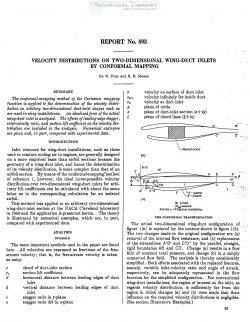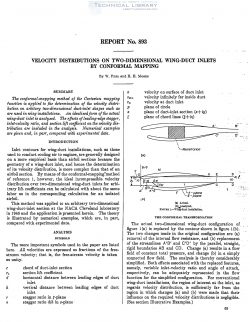naca-report-893

- Version
- 145 Downloads
- 1,023.78 KB File Size
- 1 File Count
- August 31, 2016 Create Date
- August 31, 2016 Last Updated
National Advisory Committee for Aeronautics, Report - Velocity Distributions on Two Dimensional Wing Duct Inlets by Conformal Mapping

The conformal-mapping method of the Cartesian mapping
function is applied to the determination of the velocity distri—
bution on arbitary two—dimensional duct-inlet shapes such as
are used in wing installations. An idealizedform of the actual
wing-duct inlet is analyzed. The ejects of leading-edge stagger,
inlet-velocity ratio, and section lift coqficient on the velocity dis—
tribution are included in the analysis. Numerical examples
are given and, in, part, compared with experimental data.
Inlet contours for wing-duct installations, such as those
used to conduct cooling air to engines,_are generally designed
on a. more empirical basis than airfoil sections because. the
geometry of a wing-duct inlet, and hence the determination
of its velocity distribution, is more complex than that of an
airfoil section. By means of the conformalnmappiug'method
of reference 1, however, the ideal incompressible velocity
distribution over two—dimensional wing-duct inlets for arbi-
trary lift coefficients can be calculated with about the same
labor as in the corresponding calculation for an isolated
airfoil.
This method was applied to an arbitrary two-dimensional
wing—duct—inlet section at the NACA Cleveland laboratory
in 19-15 and the application is presented herein. The theory
is illustrated by numerical examples, which are, in part,
compared with experimental data.
| File | Action |
|---|---|
| naca-report-893 Velocity Distributions on Two Dimensional Wing Duct Inlets by Conformal Mapping.pdf | Download |

Comment On This Post